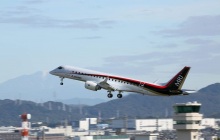
The builder of Japan’s first commercial jetliner announced that it would delay its delivery to airline customers by about a year, until 2018, in the latest of a series of setbacks for the project.
Mitsubishi Heavy Industries, a descendant of the company that made the legendary Zero fighter of World War II, said it had identified several areas requiring further investigation since the airliner’s first flight in November. Company executives, at a news conference here, cited a need to strengthen the airframe, but declined to elaborate on specific problems or possible solutions.
The Mitsubishi Regional Jet, a 70- to 90-seater designed for short-haul flights, was previously expected to join the fleet of its first customer, All Nippon Airways (ANA), in the second quarter of 2017. Mitsubishi said it now aimed to deliver the MRJ “approximately one year later,” and executives said the timetable could slip further, subject to subsequent reviews.
Analysts say the latest delay could alarm existing customers, who have placed orders or options for more than 400 of the planes, as well as discouraging other potential buyers as the jet competes with new and existing regional jets made by Bombardier and Embraer. One of the $45 million jet’s main selling points has been its next-generation technology, including fuel-efficient new engines from Pratt & Whitney, a division of United Technologies. By delaying delivery, Mitsubishi could lose a first-mover advantage over Embraer, which said it remains on track to deliver the first of its upgraded E2 jets with similar Pratt engines in 2018.
Mitsubishi Aircraft Corp. said it had conducted three flight tests, finding that the plane performed largely as planned. The company said, however, that as a result of input from U.S. experts it was working to strengthen the airframe and upgrade the system software. “We are improving the strength in order to enhance safety,” said Nobuo Kishi, senior executive vice president of Mitsubishi Aircraft. “We are recognizing that we lack experience after a 50-year gap,” he added, referring to the time that has passed since Mitsubishi joined other Japanese aircraft makers to build the propeller-driven YS-11 airliner.
When Mitsubishi Heavy began development of the jet in 2008, it had envisioned the plane’s entry into commercial service occurring as early as 2013. Since then, there have been at least four major delays. While Mitsubishi Heavy and other Japanese companies are major suppliers to Boeing Co. and Airbus Group SE, conceiving and executing a commercial airliner from scratch is vastly more complicated than providing parts for one.

 93
93
 6
6

 43
43
 1
1